Have you ever wondered why some businesses see amazing returns from their online ads while others struggle to break even? The difference often comes down to how well they manage their bidding strategy and budget allocation.
In this guide, I’ll walk you through the nuts and bolts of optimizing your ad spend for maximum impact. Whether you’re running Google Ads, Facebook campaigns, or exploring other platforms, you’ll discover practical techniques to improve your ROI without needing a marketing degree.
By the end of this post, you’ll understand how to set realistic goals, choose the right bidding strategies, and allocate your budget where it counts. Let’s dive in and turn those ad dollars into real business growth.
Understanding Bid & Budget Fundamentals
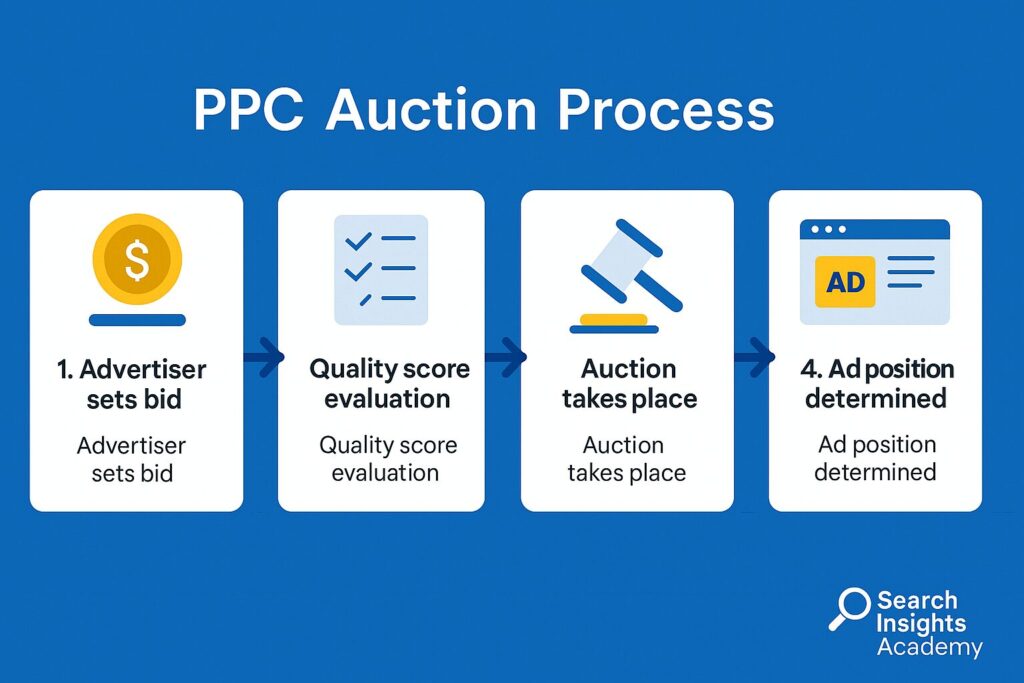
Before jumping into optimization tactics, let’s make sure we’re on the same page about what bid and budget management actually involves.
What Is Bid & Budget Management?
At its core, bid and budget management is about controlling how much you spend on your digital ads and where that money goes. Your bids determine how much you’re willing to pay for a click, impression, or conversion, while your budget sets the overall spending limit for your campaigns.
Think of your budget as the total amount in your wallet and your bids as decisions about how much you’re willing to spend on individual items. As WordStream explains, effective management means finding the sweet spot where you’re competitive enough to win ad placements without overpaying.
How Does PPC Bidding Work?
When someone searches for a keyword you’re targeting, you enter an instant auction against other advertisers. According to Google’s own documentation, this auction determines not just which ads appear, but also their position on the page.
The process works like this:
- You set how much you’re willing to pay for a click
- Google evaluates your bid amount alongside your ad quality and relevance
- This combination (not just your bid alone) determines if and where your ad appears
It’s not simply about who pays the most—it’s about who provides the most value to the searcher while being willing to pay a competitive price.
Common Misconceptions About Pay Per Click Bid Management
Many newcomers to PPC advertising fall prey to myths that can sabotage their campaigns. One persistent misconception is that you always need the highest bid to get results. Search Engine Journal debunks this idea, showing that quality score and relevance often matter more than raw bid amounts.
Another common misunderstanding is that you can “set and forget” your bids. In reality, the digital landscape changes constantly—competitors adjust strategies, seasonal trends shift consumer behavior, and even global events can impact performance overnight. Your bids need regular attention to stay effective.
Setting Realistic Goals & KPIs
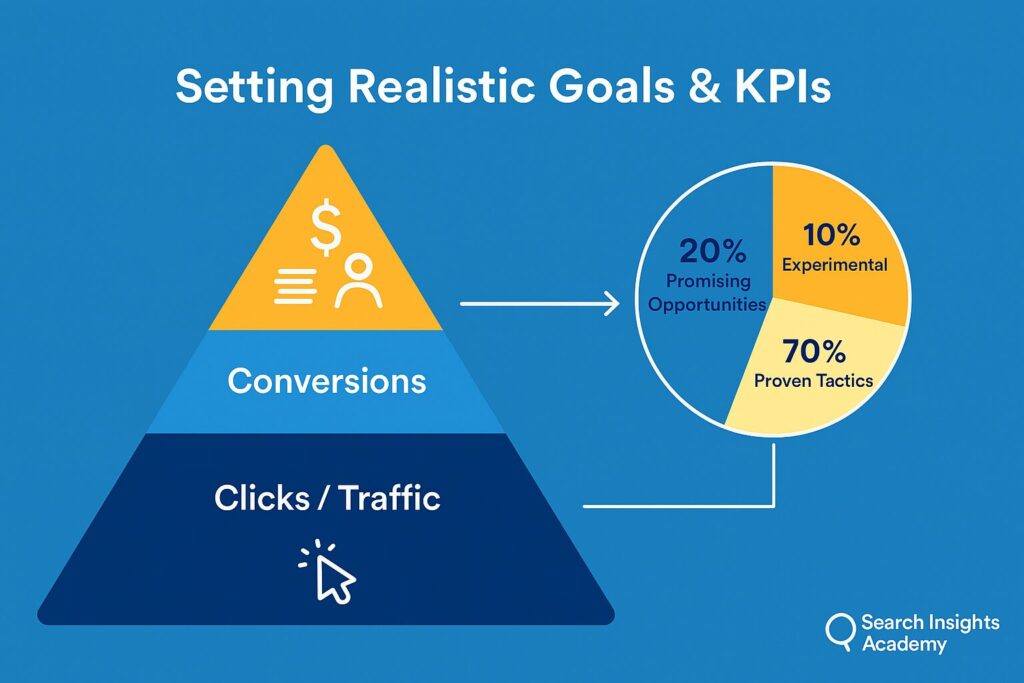
Before spending a single dollar on ads, you need clarity about what you’re trying to achieve. Otherwise, you’re essentially driving without a destination in mind.
Identifying Your Target Metrics
The metrics that matter most depend entirely on your business objectives. Are you looking to build brand awareness, generate leads, or drive direct sales? Each goal demands different metrics and bidding strategies.
For e-commerce businesses, Shopify suggests focusing on ROAS (Return On Ad Spend) and cost per conversion. Meanwhile, lead generation campaigns might prioritize cost per lead and lead quality scores.
Don’t fall into the trap of chasing vanity metrics like impressions or clicks if they don’t translate to business outcomes. As HubSpot notes, the most important KPIs are those that directly impact your bottom line.
How Do I Know If My PPC Budget Is Sufficient?
Your budget is probably too small if you consistently hit your daily spending limits early in the day—this means you’re missing potential opportunities. On the flip side, if you’re spending your full budget but seeing poor performance, the issue might be with your targeting or creative rather than your budget size.
According to Neil Patel, a good approach is to work backward from your goals. If you know your average conversion rate and value per conversion, you can calculate how many clicks you need and how much you can afford to pay for each one.
Remember that different markets have different costs. Competitive niches like insurance or legal services generally have higher CPCs than hobby-related keywords. This applies globally, though you might find regional variations—for instance, CPCs in the Australian financial sector might differ from those in the UK or US markets.
Balancing ROI and Growth Objectives
There’s often tension between immediate ROI and long-term growth. A campaign focused purely on ROI might stick to safe, proven keywords and tactics. Meanwhile, a growth-focused approach might accept higher costs to expand reach and test new opportunities.
Marketing Insider Group recommends the 70-20-10 rule: put 70% of your budget toward proven tactics with reliable returns, 20% toward promising opportunities with some data backing, and 10% toward experimental approaches that could unlock new growth avenues.
This balanced approach helps you maintain performance today while discovering the opportunities that will fuel tomorrow’s growth.
Crafting an Effective Bid Strategy
Now that we’ve covered the fundamentals, let’s look at practical bid strategies that can help you maximize ROI.
Manual vs Automated Bidding: Which Is Right for Me?
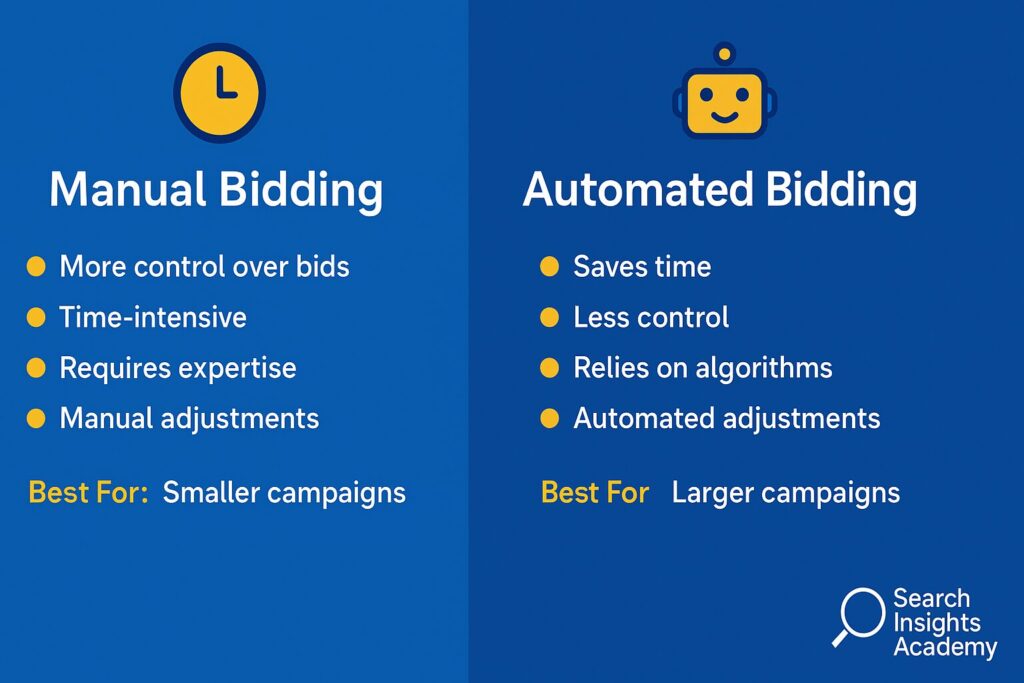
The choice between manual and automated bidding depends on your campaign size, expertise level, and available time. Manual bidding gives you complete control but requires significant time and knowledge. You’ll need to regularly analyze performance data and adjust bids accordingly.
Automated bidding lets Google’s algorithms set bids based on your goals. According to Search Engine Land, automated strategies work best when you have:
- Sufficient conversion data (typically 15-30 conversions per month)
- Stable campaign goals
- Accurate conversion tracking
Many advertisers find success with a hybrid approach—using automated bidding for larger campaigns while maintaining manual control over smaller or newer campaigns where they’re still gathering data.
How Can I Reduce My CPC in Australia and Worldwide
High CPCs are a universal challenge for advertisers, but there are proven ways to bring them down. WordStream’s research shows that improving your Quality Score is one of the most effective methods—each point of improvement can reduce your CPC by up to 16%.
Other effective tactics include:
- Using long-tail keywords with more specific intent and often lower competition
- Implementing geotargeting to focus on your most profitable locations
- Creating tightly themed ad groups with highly relevant ad copy
- Scheduling ads during your highest-converting times of day
In Australia specifically, local businesses can benefit from location-specific keywords (like “plumber in Sydney”) and adjusting bids for different states and territories based on performance data.
Dynamic Bidding: When and How to Use It
Dynamic bidding adjusts your bids in real-time based on how likely a conversion is. For example, Google’s Enhanced CPC automatically increases bids for clicks that seem more likely to convert and decreases them when conversion seems less likely.
This approach works particularly well when:
- You have consistent conversion patterns
- Your audience behavior varies by time, device, or location
- You want to maintain some control while leveraging Google’s machine learning
One common mistake is activating dynamic bidding too early in a campaign’s life. You need sufficient conversion data first—otherwise, the algorithm lacks the information needed to make smart adjustments.
Leveraging Bid Management Tools for PPC Success
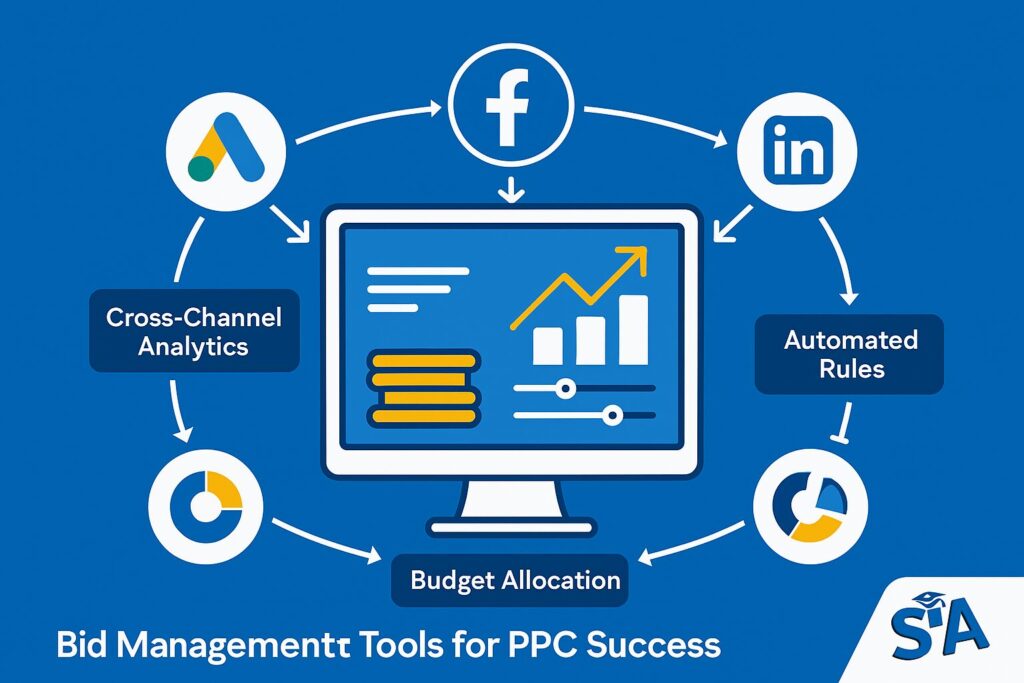
The right tools can dramatically simplify bid management and improve your results. Let’s explore how to choose and use them effectively.
Comparing Popular PPC Bid Management Tools
While Google Ads offers built-in bid management features, third-party tools can provide additional capabilities, especially if you’re advertising across multiple platforms.
According to Marketing Land’s comparison, leading options include:
- Kenshoo: Enterprise-level solution with advanced automation and analytics
- Marin Software: Offers cross-channel optimization and budget allocation
- WordStream: User-friendly interface ideal for small to mid-sized businesses
- Acquisio: Strong automated bidding algorithms with machine learning
Your choice depends on your budget, technical expertise, and specific needs. Smaller businesses might start with Google’s native tools or affordable options like WordStream, while larger enterprises often benefit from the comprehensive capabilities of platforms like Kenshoo or Marin.
How Often Should I Review and Adjust My Bids?
The ideal frequency for bid adjustments depends on your campaign size, competition level, and market volatility. PPC Hero recommends weekly reviews for most accounts, with more frequent checks during:
- Seasonal peaks
- Promotional periods
- After significant campaign changes
- In highly competitive markets
I’ve found that small accounts might need adjustments every 1-2 weeks, while larger accounts with substantial daily spend often benefit from twice-weekly or even daily reviews. The key is establishing a regular schedule rather than making sporadic changes.
Integrating Bid Management Software for Seamless Campaign Optimisation
Most bid management platforms integrate with major advertising channels through APIs, allowing you to control multiple campaigns from a single interface. According to Search Engine Land, effective integration requires:
- Proper conversion tracking setup across all platforms
- Consistent naming conventions for campaigns
- Clear rules and parameters for automated adjustments
- Regular audits to ensure data flows correctly
When properly integrated, these tools can save hours of manual work while improving performance through data-driven decision making that would be impossible to achieve manually.
Paid Social Optimisation Techniques

Social media advertising plays by different rules than search advertising. Let’s look at how to optimize your social campaigns for maximum ROI.
Key Differences Between PPC and Paid Social Campaigns
The fundamental difference between search and social advertising is user intent. As Buffer explains, search users actively look for solutions, while social users are browsing content and unexpectedly encounter your ads.
This distinction affects multiple aspects of campaign management:
- Targeting: Search focuses on keywords; social focuses on demographics, interests, and behaviors
- Creative: Social demands more attention-grabbing visuals and copy to interrupt scrolling
- Bidding: Social platforms often optimize for engagement metrics before conversions
- Measurement: Attribution can be more challenging with social’s longer conversion paths
Understanding these differences helps you set appropriate expectations and strategies for each channel rather than applying search tactics to social campaigns.
How Can I Optimise Bids on Facebook and Other Social Platforms?
Each social platform has its own bidding system, but some principles apply universally. Facebook’s Business Help Center explains that their algorithm favors ads that create positive user experiences, not just those with the highest bids.
For optimal results across platforms:
- Match your bid strategy to your campaign objective (awareness vs. conversion)
- Use lifetime value data to inform bidding decisions for customer acquisition
- Test different bid strategies (cost cap vs. bid cap) to find what works for your specific audience
- Leverage platform-specific features like Facebook’s value optimization for e-commerce
Remember that social platforms have strong machine learning capabilities—sometimes giving them clear objectives and sufficient learning time produces better results than micromanaging bids.
Measuring Paid Social Performance Metrics
Social media offers unique metrics beyond the standard clicks and conversions. Social Media Examiner highlights engagement metrics like shares, comments, and video views as important indicators of ad resonance.
However, don’t lose sight of business objectives. A highly shared ad that generates no leads or sales might entertain but fail to deliver ROI. Balance engagement metrics with hard conversion data to get the complete picture.
Many marketers use blended attribution models for social campaigns, recognizing that these platforms often influence purchases even when they’re not the final click before conversion.
Budget Management Best Practices
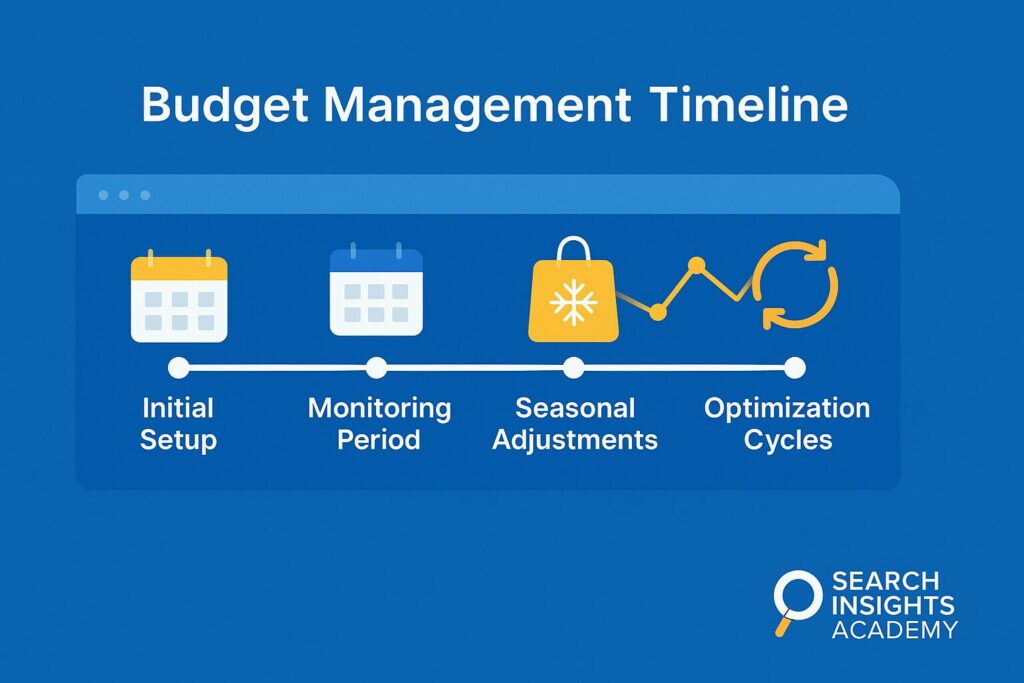
Even the best bidding strategy can’t overcome poor budget management. Let’s explore how to allocate your funds effectively.
Daily vs Monthly Budgets: Which Strategy Works Best?
The choice between daily and monthly budgets depends on your campaign goals and spending patterns. Google Ads Help Center explains that daily budgets give you tighter control but might limit performance on high-opportunity days.
Monthly budgets (or “shared budgets” in Google terminology) offer more flexibility, allowing the system to spend more on high-performing days and less when opportunities are scarce. This approach can be particularly effective for:
- Campaigns with fluctuating daily performance
- Seasonal businesses with variable traffic patterns
- Accounts with multiple related campaigns competing for the same budget
Many marketers globally use a hybrid approach—setting monthly targets but monitoring daily spend to stay on track. This provides both flexibility and control.
How Do I Prevent Overspending and Budget Waste?
Budget waste often comes from poor targeting rather than technical issues. WordStream’s data shows that up to 76% of ad budgets can be wasted on non-converting traffic.
To minimize waste:
- Use negative keywords aggressively: Regularly review search terms reports and exclude irrelevant queries
- Implement dayparting: Schedule ads during your highest-converting hours
- Set device bid adjustments: Allocate more budget to devices that convert better
- Create audience exclusions: Stop showing ads to users who are unlikely to convert
These strategies work globally—though the specific high-converting times or devices might vary by region and audience.
Seasonal Adjustments for Global Markets
Seasonal trends affect nearly every business, but these patterns vary widely across regions and industries. While Christmas drives retail sales globally, the Southern Hemisphere experiences summer during December-February, changing seasonal shopping behaviors compared to Northern Hemisphere markets.
Think With Google research shows that proactively adjusting budgets for seasonal fluctuations can improve ROI by 20-30%. This means:
- Increasing budgets 2-4 weeks before your peak season begins
- Adjusting bids higher for seasonal terms during peak periods
- Creating season-specific ad copy and landing pages
- Reducing spend during predictable low periods
For international campaigns, create a calendar of regional events and holidays that might affect performance in each market.
Maximising Paid Media Performance
Beyond basic bid and budget management, certain optimization techniques can significantly improve your campaign performance.
Tracking and Analysing Conversions
Proper conversion tracking is non-negotiable for effective campaign optimization. According to CXL Institute’s research, businesses with advanced conversion tracking achieve up to 50% better ROAS than those with basic setups.
To implement robust tracking:
- Track multiple conversion points (calls, form submissions, purchases)
- Assign different values to different conversion types
- Use Google Analytics to understand post-click behavior
- Implement cross-device and cross-platform tracking where possible
Beyond installation, regularly verify your tracking accuracy. Discrepancies between platform data and actual business results can lead to poor optimization decisions.
Identifying Quick Wins for Faster Results
When you need to improve performance quickly, focus on high-impact adjustments. Search Engine Journal recommends these “low-hanging fruit” opportunities:
- Pause significantly underperforming keywords or ads: If they cost a lot but rarely convert, cutting them immediately improves ROI
- Increase bids on high-converting keywords near position 2-4: Moving these to position 1 often yields more conversions
- Improve ad extensions: Add or update site links, callouts, and structured snippets for higher CTR
- Fix quality score issues: Identify and improve landing page relevance for your most expensive keywords
These tactics can often deliver noticeable improvements within days rather than weeks or months.
How Do I Maintain Consistent ROI Across Multiple Channels?
Managing campaigns across Google, Facebook, LinkedIn, and other platforms introduces complexity. Marketing Land suggests these approaches for consistent cross-channel ROI:
- Unified attribution: Implement consistent conversion tracking across all platforms
- Channel-specific KPIs: Recognize that each channel may perform differently and set appropriate targets
- Regular reallocation: Review cross-channel performance at least monthly and shift budget to higher-performing channels
- Consistent testing protocols: Use similar testing methodologies across platforms to compare results accurately
Many successful marketers use portfolio bidding approaches—treating all channels as a single investment portfolio and optimizing for overall returns rather than siloed performance.
Common Pitfalls and How to Avoid Them
Even experienced marketers make mistakes with bid and budget management. Here are some common pitfalls and how to avoid them.
Overbidding on Low-Intent Keywords
High search volume doesn’t always translate to high conversion potential. Ahrefs’ research shows that keywords with commercial intent (“buy,” “price,” “best”) convert significantly better than informational queries.
To avoid wasteful spending:
- Categorize keywords by intent (navigational, informational, commercial, transactional)
- Bid higher on high-intent terms closest to purchase decisions
- Use audience targeting to reach users further along in the buying journey
- Develop content marketing for informational queries rather than high-CPC ads
This approach works across all markets, though the specific high-converting terms may vary by region and language.
Ignoring Data-Driven Insights
It’s easy to get attached to specific keywords or creative approaches, but data should drive decisions. HubSpot’s State of Marketing Report found that data-driven marketers are 58% more likely to exceed revenue goals.
Common data oversights include:
- Not segmenting performance by device, location, or time of day
- Ignoring assisted conversions in attribution models
- Making decisions based on too little data (statistical significance matters)
- Failing to connect ad performance to actual business outcomes
Set up regular data review sessions where you challenge assumptions and let performance metrics guide strategy adjustments.
Why Do Some Campaigns Fail Despite High Bids?
High bids alone can’t save a poorly constructed campaign. According to WordStream, these factors often cause failure despite adequate spending:
- Disconnect between ads and landing pages: If visitors don’t find what they expect after clicking, they’ll bounce
- Poor audience targeting: Showing ads to the wrong people wastes money regardless of bid amount
- Weak value proposition: If your offer isn’t compelling, no amount of visibility will generate conversions
- Website experience issues: Slow load times, confusing navigation, or poor mobile experience kill conversion rates
The solution is a holistic approach that considers the entire customer journey, not just the bidding strategy. Even perfect bids can’t overcome fundamental issues with targeting, messaging, or user experience.
FAQs and Troubleshooting
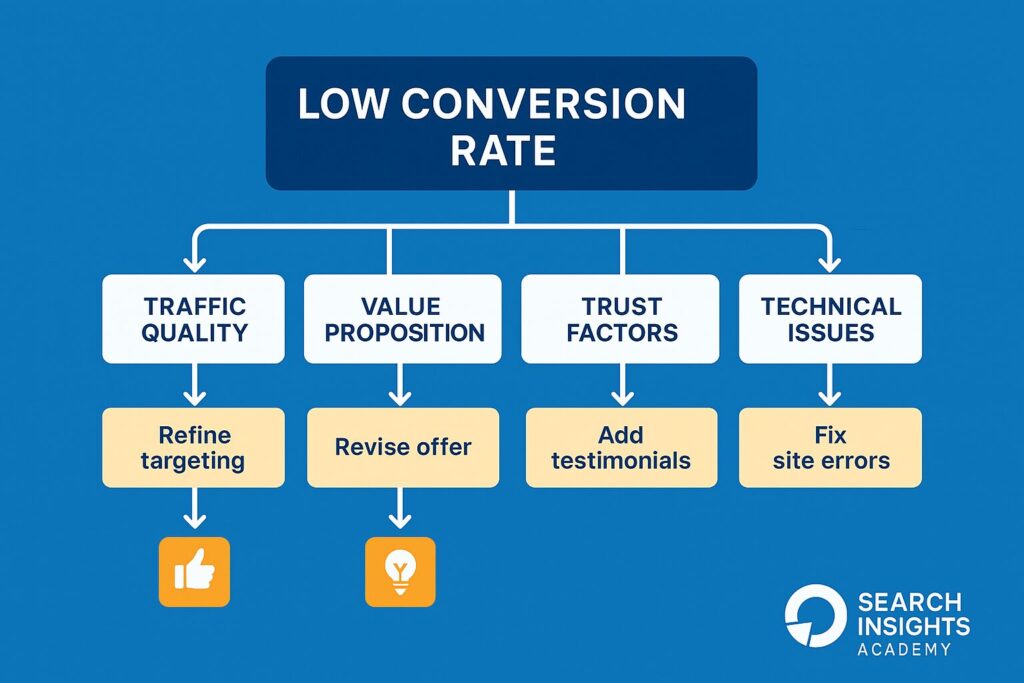
Let’s address some common questions that arise when optimizing bids and budgets.
“Why Isn’t My PPC Campaign Converting?”
Low conversion rates stem from multiple potential issues. CXL’s conversion research identifies these common culprits:
- Traffic quality: Your targeting might be too broad, bringing in unqualified visitors
- Value proposition clarity: Your landing page might not clearly communicate benefits
- Trust factors: Missing social proof, testimonials, or security indicators can reduce conversions
- Technical issues: Form errors, loading problems, or broken elements may prevent conversions
Start troubleshooting by analyzing your bounce rate and time on site. High bounce rates often indicate a mismatch between ad promises and landing page experience. Next, set up heat mapping tools like Hotjar to see how users interact with your pages and identify potential friction points.
“Should I Pause Low-Performing Keywords or Adjust Bids?”
This common dilemma depends on several factors. According to PPC Hero, consider these questions:
- Has the keyword ever converted? If yes, bid adjustments might revive performance
- Is the keyword highly relevant to your offerings? Relevant terms might be worth optimizing
- Is the sample size significant enough to make a decision? Don’t pause based on limited data
- Could the keyword be valuable for assisted conversions? Check attribution models before deciding
As a general rule, give new keywords 2-4 weeks or at least 200-300 clicks before deciding. For established keywords with sufficient data showing poor performance, pausing is often better than continuous adjustments.
“Is It Better to Focus on CPC or CPA for Budget Management?”
The metric that matters most depends on your campaign objectives. Google’s own marketing team suggests:
- CPC focus works best for: Awareness campaigns, brand building, content promotion
- CPA focus works best for: Direct response, lead generation, sales-driven campaigns
In practice, many successful marketers use a blended approach—monitoring CPC for efficiency while optimizing toward CPA or ROAS targets. This ensures you’re both acquiring traffic efficiently and converting that traffic at an acceptable cost.
Remember that over-focusing on CPA can sometimes limit scale. If you have strict CPA targets, you might miss opportunities to acquire customers at slightly higher costs that would still be profitable long-term.
Case Study: Improving ROI with Strategic Bid & Budget Management
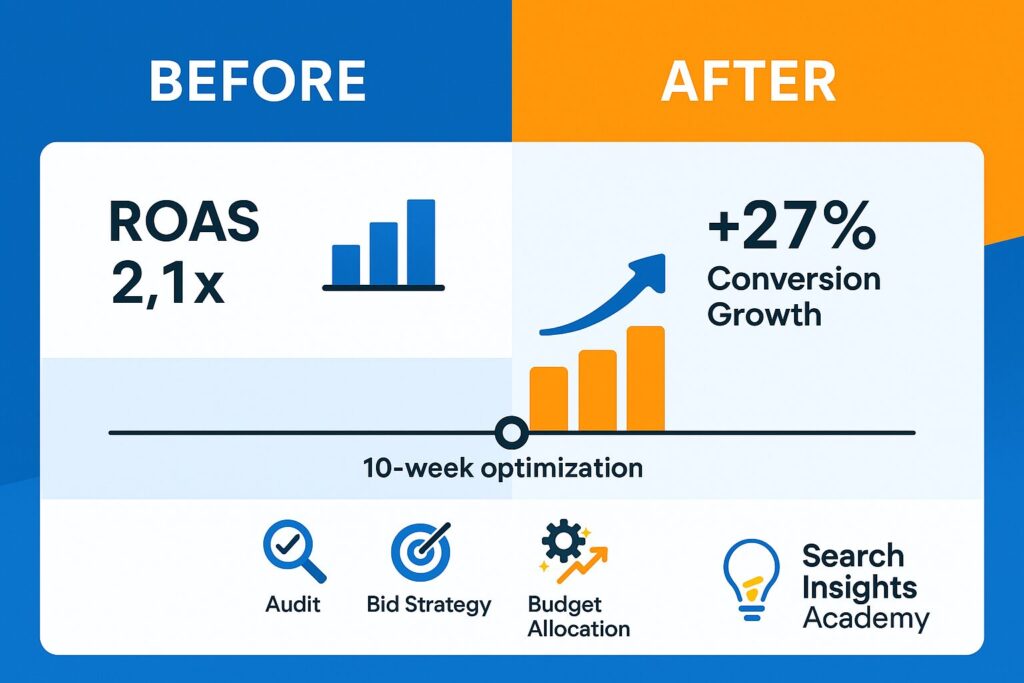
Real-world examples often illustrate principles better than theory alone. Let’s look at how strategic bid management transformed results for one business.
Real-World Example from an E-Commerce Brand
An online sustainable fashion retailer wanted to expand their market reach while maintaining profitable customer acquisition costs. Their initial campaigns had steady but unspectacular results—a 2.1x ROAS with average CPCs of $1.85.
The team implemented a structured optimization strategy:
- Segmentation: They separated campaigns by product category and purchase intent, allowing more granular bid control
- Audience layering: They applied audience targeting to their search campaigns, increasing bids for past site visitors and email subscribers
- Automated bidding: They switched to Target ROAS bidding but only after gathering 3 months of solid conversion data
- Budget shifting: They implemented weekly performance reviews and reallocated budget from underperforming segments to top performers
According to Search Engine Land’s case study collection, this methodical approach delivered impressive results. Within 10 weeks, ROAS increased to 3.4x while total conversion volume grew by 27%. The average CPC actually decreased to $1.62 despite expanding to more competitive keywords.
Key Takeaways and Lessons Learned
This case study exemplifies several principles that apply across industries and markets:
- Data-driven segmentation: Dividing campaigns into logical segments enables more precise optimization
- Progressive automation: Starting with manual control and transitioning to automation after gathering data produced better results than immediate automation
- Audience insights: Incorporating customer data into bidding decisions improved targeting efficiency
- Regular reallocation: Consistently shifting budget toward higher-performing elements maintained momentum
Econsultancy’s best practice research confirms these approaches work across markets, though the specific implementation details may vary by industry and platform.
The most important lesson? Successful bid optimization isn’t a one-time event but an ongoing process of testing, measuring, and refining based on actual performance data.
Conclusion and Next Steps
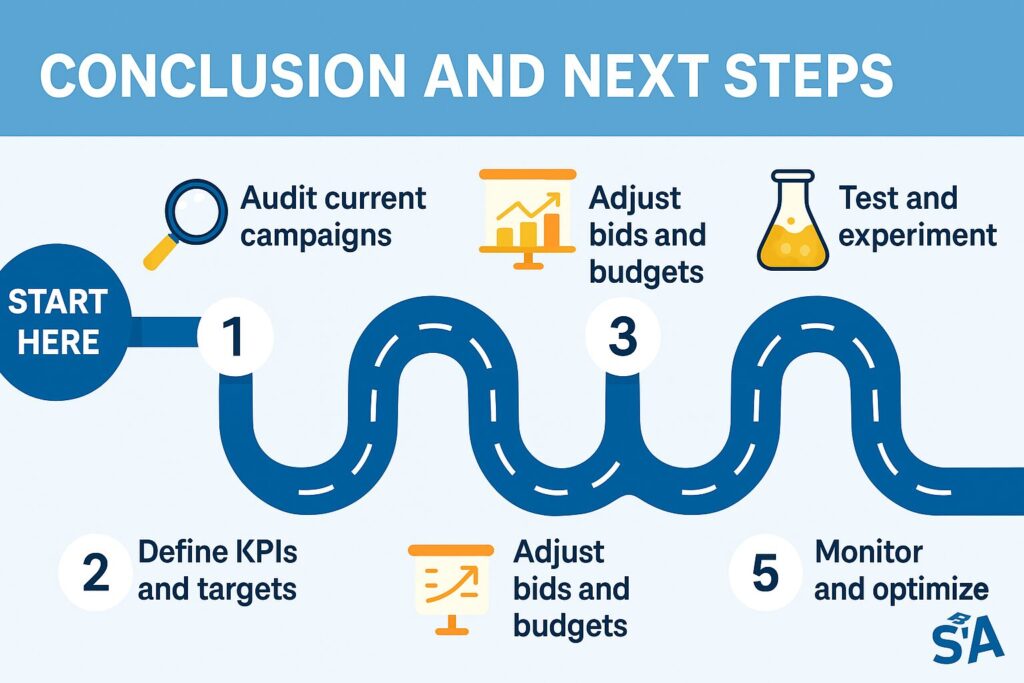
Mastering bid and budget management isn’t an overnight achievement—it’s an ongoing journey of refinement and optimization. The strategies we’ve covered work across platforms and markets, though you’ll need to adapt them to your specific business context.
To implement what you’ve learned:
- Audit your current campaigns: Identify underperforming elements and optimization opportunities
- Define clear KPIs: Ensure your metrics align with actual business objectives
- Test bidding strategies: Experiment with different approaches on a portion of your budget before full implementation
- Develop regular review processes: Schedule weekly or bi-weekly optimization sessions
- Consider tools: Evaluate whether bid management tools would improve your efficiency and results
Remember that even small improvements in your bidding efficiency can dramatically impact your overall marketing ROI. A 10% reduction in CPC or a 15% improvement in conversion rate can transform a break-even campaign into a profitable growth driver.
What bid optimization techniques have worked best for your business? Are there specific challenges you’re facing with budget management? Share your experiences in the comments below—I’d love to hear your perspective and offer additional insights.Add to Conversation


